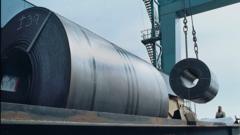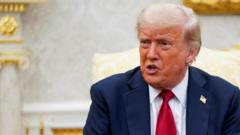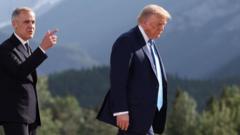President Trump has signed an order increasing tariffs on steel and aluminium imports to 50%, raising concerns over potential economic fallout and retaliatory measures from trade partners. While the administration defends the move as necessary for protecting the American steel industry, critics warn of wide-ranging negative impacts on U.S. businesses and foreign relations.
US President Trump's Steel and Aluminium Tariffs Surge to 50%, Sparking Economic Concerns

US President Trump's Steel and Aluminium Tariffs Surge to 50%, Sparking Economic Concerns
In a significant escalation of trade policy, President Trump has announced the doubling of tariffs on steel and aluminium imports from 25% to 50%, raising alarm among industry stakeholders and international trade partners.
In a bold move that is set to reshape the landscape of international trade, President Donald Trump has recently signed an order that doubles tariffs on imports of steel and aluminium from the previous rate of 25% to an unprecedented 50%. This significant shift follows a series of tariff adjustments made since March and will take effect starting Wednesday.
The administration has stated that the new tariffs are designed to bolster the American steel industry, a vital sector according to Trump, who asserts that protection is key to safeguarding national interests. Nevertheless, many economic analysts and industry insiders express skepticism, suggesting that the increased tariffs could have detrimental effects not only on foreign producers but also on American manufacturers who rely heavily on these metals.
Amid the announcement, several businesses directly impacted by the tariffs were caught off guard. Many had hoped the policy would be temporary or merely a negotiating tactic. Rick Huether, CEO of Independent Can Co. in Maryland, expressed his concerns over the chaotic environment created by the U.S. government's abrupt decisions. This sentiment was echoed across various manufacturing sectors, which foresee rising prices forcing customers to seek alternatives.
Though the United States stands as the world's largest steel importer after the European Union, the new tariffs may further complicate trade relations with countries like Canada, Brazil, Mexico, and South Korea – the primary sources of U.S. steel imports. Critics argue that the previously established exemptions for certain imports have already been compromised, particularly following Trump's recent assertion to dismantle these carve-outs.
At a rally in March, Trump emphasized a desire to make tariffs prohibitively high to ensure American companies purchase from domestic suppliers instead. "Nobody's going to get around that," he stated passionately about the new rates, which, according to some industry experts, are expected to stifle imports significantly.
International response has been swift; reactions from the UK and Europe indicate serious concern regarding potential retaliatory measures. Following the announcement, officials from the European Commission indicated ongoing negotiations aimed at reaching favorable trade agreements to mitigate the effects of the tariffs. In the UK, Trade Secretary Jonathan Reynolds has noted that the UK managed to evade the increased tariffs, maintaining a 25% rate through continued discussions with U.S. counterparts.
However, industry representatives in the UK, such as Gareth Stace of UK Steel, warned of dire consequences should the tariffs apply. They perceive that the 50% increase would lead to the instantaneous cancellation of orders and cause significant harm to UK exports.
Economists caution that the tariffs may not only jeopardize foreign trade relations but could backfire on the U.S. economy itself—potentially leading to job losses that far exceed any gains in the steel sector. Analysis reveals that while Trump’s initial tariffs created some jobs in steel, they resulted in approximately 75,000 losses across other industries such as construction and manufacturing.
With unsettling changes already on the horizon, many American businesses are bracing for substantial increases in production costs. Chad Bartusek, a small business owner in Illinois, recently recounted his shock after learning that his anticipated tariff costs had nearly doubled to $145,000 due to the latest hike. As companies grapple with soaring prices for steel and aluminium, many including Bartusek have been compelled to implement hiring freezes or cut back on worker hours, apprehending further instability as the impacts of the tariffs continue to unfold.





















